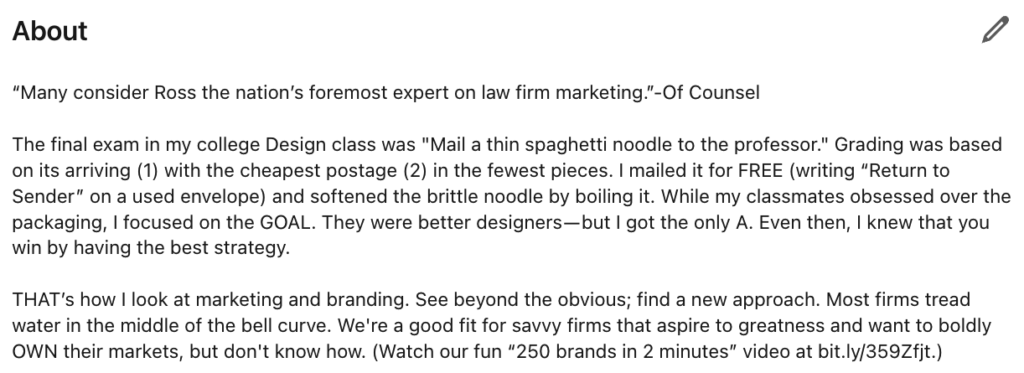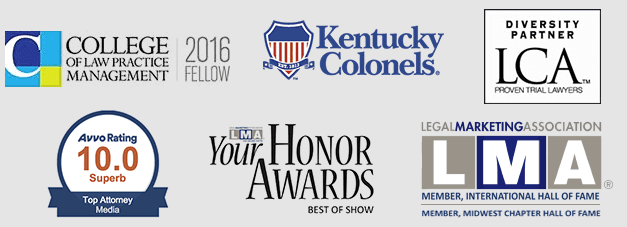[This is the second part of a 2-part blog post regarding lawyers and LinkedIn. Read Part One here.]
Here’s a senior lawyer’s “About” section I like.
It tells the story of one of the nation’s top trial lawyers, a good friend. I felt he had the opportunity to not just showcase his remarkable skills and win-loss record in massive jury trials, but also show his friendly, low-ego personality that juries find persuasive. He has also discovered that people find his Maltese background to be interesting, and he uses it as a hook in getting remembered.
Here is the opening of his LinkedIn “About” summary:
Now rate him on a scale of 1-10 for the quality of his technical skills.
One is “awful.” Ten is “awesome.” What score would you give him? I’ll bet you’d give him at least a 7+. Whether you gave him a 5 or a 10 doesn’t matter–the point is, after reading his LinkedIn profile, you feel like you now are in a position to evaluate his technical skills.
So at least we can agree that a LinkedIn profile CAN influence how you feel about a lawyer’s expertise―either positively or negatively. And if that’s the case, why wouldn’t you do whatever you can to look like a “10” to your future prospects?
What should you do? Here’s the first step:
Go to LinkedIn.com. In the box, search for your name. Analyze what shows up.
Do you have two or three half-empty profiles from when you worked at previous firms? I’d estimate that 25% of lawyers unknowingly have multiple profiles. (Or they know, but can’t figure out how to delete them.)
Act like a prospect who is looking for more info about you. Click on your name. What are the results? Are you proud of it? Does it showcase you as a high-quality professional? Or do you have an empty shell with “1 connection”?
A bare profile makes prospects wonder if you’re obsolete.
Filling out a basic profile is something you can do over lunch. At a minimum, add basic biography content into the narrative About and Experience sections. Include a professional-looking photo and basic contact information. You want to make it easy for prospects to find you, so help them.
Now go back over the narratives and try to infuse a bit more of your personality into them than your firm’s staid, formulaic website bio. Pay serious attention to the About section.
Here’s how my profile starts:

Note (after a quick media quote for credibility), I’m not listing precisely what I do yet. I’m first trying to convey that my approach is different than my competitors’, using an old story to make the point. [Connect with me!]
Too many lawyer profiles are simply bullet-pointed litanies of the things they do. That is, they describe a typical corporate, litigation, or real estate practice, and claim to be really good at it―just like all their competitors. There’s no drama. No evidence. No story.
Instead, show your readers why you do what you do; help them feel your passion for their success.
Here’s the first part of a LinkedIn profile I wrote for Glaser Weil’s Peter Sheridan, one of the nation’s top construction lawyers:
Don’t you want someone like him to represent you?
We’ve shown his lifelong passion for construction, just like his clients. He was built for this, he absolutely loves architecture and construction. And his clients love that about him. Read the entire profile here.
Or read this one, describing how the blue-collar upbringing of a regional law firm’s chairman informs how he approaches his practice and leadership. It’s designed to provide potential laterals a sense of the culture they can expect if they were to join the firm:
“I guess the point is, deep down I’m just a hard-working blue-collar guy with a law degree and I’m proud to work at a firm that embodies those characteristics….”
Here’s how it starts:
Or here’s one for a hard-charging trial lawyer.
Unlike the Maltese defense lawyer showcased at the top, who wins in part because juries learn to trust his obvious decency and integrity, this trial lawyer is a killer. So we hit the reader right between the eyes:

We don’t pretend that he has a kind or decent personality. His story is about taking the biggest, toughest cases to trial… and winning. (More of his “About” profile is in Part I.)
So consider, what’s YOUR story? What makes you different?
First, figure out the answer to that question, then start writing. If you don’t know or can’t figure it out, ask your best friends and family why they’d trust you to handle their most vital legal issues. They’ll likely have an answer for you. Perhaps you can start there.
If you don’t have a marketing department or don’t want to ask them, feel free to contact me directly and I’ll walk you through it―it’d be my way of saying “thanks for reading.”
————————–
Need LinkedIn training for your lawyers? Call Ross now for a quote on one of his dozens of popular programs!
Here’s a link to a speaker video.






